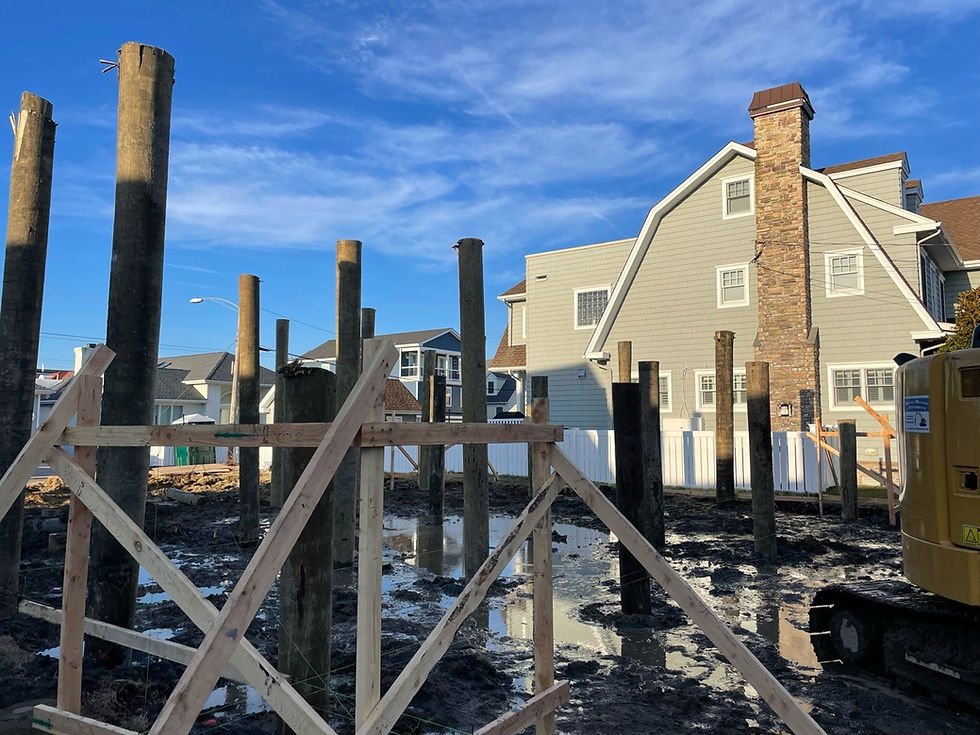The Future of Coastal Resilience: Building Stronger Foundations Against Rising Seas
- SJ Hauck Construction
- Sep 22
- 3 min read

Along the East Coast, coastal communities face a growing challenge: how to build homes and structures that can withstand rising seas, stronger storms, and shifting shorelines. Foundations are the first—and most critical—line of defense. A properly designed coastal foundation doesn’t just hold up a house; it protects families, investments, and entire communities.
So, what does it take to build smarter and stronger by the shore? Let’s break it down.
What Is the Best Foundation for a Coastal House?
It's not as straightforward as you think.
The best foundation for a coastal house is one that elevates the structure above floodwaters while anchoring it securely against erosion, wave action, and high winds. In most cases, this means pile or pier foundations, which raise the home on tall, deep-embedded supports.
Pile foundations are long columns—made of timber, concrete, or steel—driven deep into the ground to transfer loads to stable soil layers.
Pier foundations use vertical posts set into concrete pads to create a raised platform.
Both systems allow water to flow beneath the structure instead of pushing against it, dramatically reducing flood and storm damage.
What Are the Four Types of Foundations?
While inland construction often relies on shallow foundations, coastal homes demand more robust solutions. In general, there are four main types of foundations used in residential construction:
Slab-on-Grade Foundation
A flat, concrete slab poured directly on the ground.
Common inland, but not suitable for flood-prone coastal areas.
Crawl Space Foundation
Short walls elevate the home a few feet off the ground, creating a small crawl space.
Better than slabs but still vulnerable in high-flood zones.
Basement Foundation
A full underground level, common in colder climates.
Rare and unsafe in coastal zones due to flooding risks.
Pile and Pier Foundations
Long, embedded supports (timber, steel, or concrete) that elevate the home well above Base Flood Elevation (BFE).
The gold standard for coastal construction.
For most East Coast shorelines, pile and pier systems are the only foundations that meet FEMA flood zone requirements and withstand coastal forces.
What Is the Best Building Material for Coastal Homes?
The right material can make or break a coastal foundation. Builders must choose flood-damage-resistant and corrosion-resistant materials that can handle saltwater, moisture, and relentless winds.
Pressure-treated timber: Widely used and cost-effective, especially for residential pile foundations.
Concrete: Durable and resistant to moisture when reinforced and properly treated.
Steel: Extremely strong, often used for piers and commercial marine construction, but must be galvanized or coated to resist corrosion.
The best choice depends on project scope, soil conditions, and local regulations—but all materials should be carefully engineered for longevity in a marine environment.
Are Pile Foundations Commonly Used in Coastal Areas?
Absolutely. Pile foundations are the backbone of coastal construction. They are not just common—they are essential. FEMA and state building codes often require piles in V Zones and Coastal A Zones, where storm surge and wave action pose the greatest risks.
Advantages of pile foundations include:
Elevation above flood levels
Resistance to erosion and scour
Ability to transfer loads to deeper, stable soils
Flexibility for different soil conditions
Whether it’s a single-family shore house or a large marina project, pile foundations are the standard solution for building safely by the water.
Why Coastal Foundations Differ From Others
Unlike inland builds, coastal foundations face a unique set of challenges:
Storm Surge & Flooding: Elevated foundations allow water to pass through without pushing the home off its base.
Erosion & Scour: Deep embedment prevents soil loss from undermining the structure.
High Winds & Lateral Forces: Bracing and strong connections create a continuous load path from the roof to the soil.
Saltwater Corrosion: Every material must resist the relentless effects of salt and moisture.
Meeting these challenges requires a mix of engineering expertise, quality materials, and careful compliance with FEMA and local codes.
Looking Ahead: Building Resilient Coastal Communities
As climate change reshapes coastlines, the future of construction lies in resilience. Strong foundations—whether timber piles, steel piers, or advanced helical systems—help homeowners safeguard their property and ensure that communities up and down the East Coast can weather the storms ahead.
At SJ Hauck Construction, we’ve seen firsthand how the right foundation saves not just buildings, but peace of mind. From New Jersey to Florida, we bring the expertise needed to build stronger, smarter, and safer for generations to come.



Comments